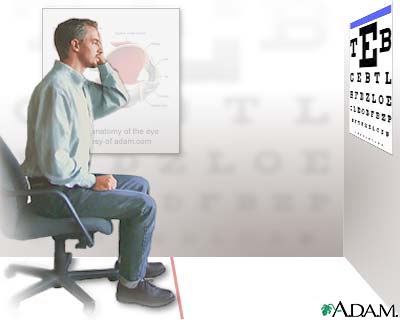Treatment
The main treatment involves patching the normal eye to force use of the lazy eye. Sometimes, drops are used to blur the vision of the normal eye instead of putting a patch on it.
The underlying condition will also require treatment. If the lazy eye is due to a vision problem (nearsightedness or farsightedness), glasses or contact lenses will be prescribed.

For treatment of crossed eyes, see: Strabismus
Children whose vision cannot be expected to fully recover should wear glasses with protective lenses of polycarbonate, as should all children with only one good eye caused by any disorder. Polycarbonate glasses are shatter- and scratch-resistant.
Prognosis (Expectations)
Children who receive treatment before age 5 usually have a near complete recovery of normal vision.
Delaying treatment can result in permanent vision problems. After age 10, only a partial recovery of vision can be expected.
Complications
* Eye muscle problems that may require several surgeries, which can have complications
* Permanent vision loss in the affected eye
Calling Your Health Care Provider
Call for an appointment with your health care provider or ophthalmologist if a vision problem is suspected in a young child.
Amblyopia: Overview, Causes
Amblyopia: Symptoms & Signs, Diagnosis & Tests
Amblyopia: Treatment
Reviewed By : Daniel B. Hoch, PhD, MD, Assistant Professor of Neurology, Harvard Medical School, Department of Neurology, Massachusetts General Hospital. Also reviewed by David Zieve, MD, MHA, Medical Director, A.D.A.M., Inc.
